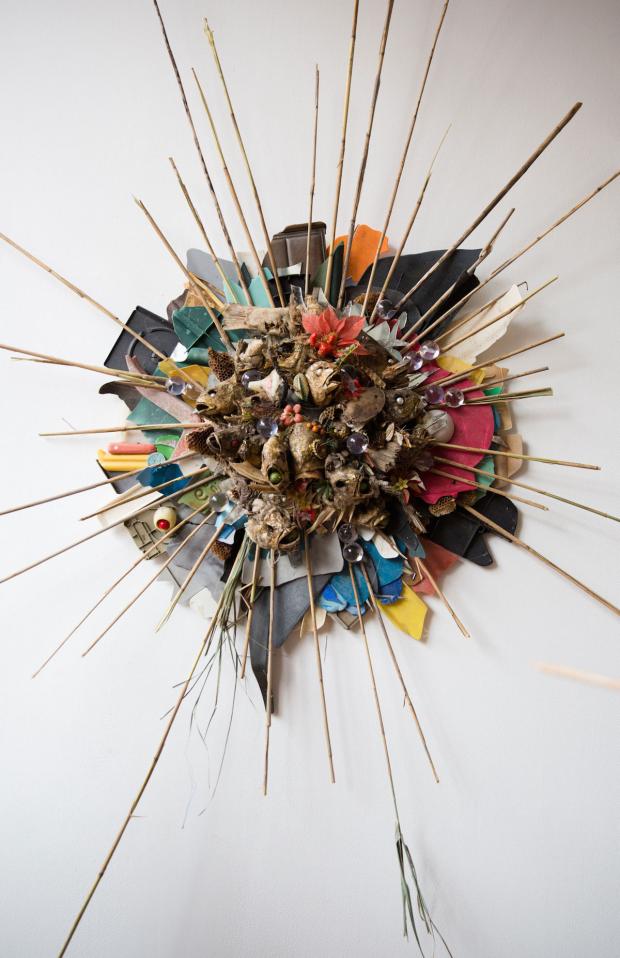Lara Buckley: Altars of ERIE
Artist Lara Buckley is best known as a musician, whose songs and singing nearly defy description. (In fact, we won’t try: Here’s a link. Do use it.) Her music is cousin to endeavors for which she is also known in a rarefied community: as a naturalist, an observer of the environments in which she moves, with particular devotion to the odd corners, to urban ecologies, to undervalued manifestations of life; and as a transformer of a property at Hickory and Broadway into an urban tree (and other living processes) farm, which also hosts likeminded musicians and artists from time to time.
Tonight at Box Gallery (667 Main Street, attached to the Hostel Buffalo Niagara), 8-11pm, Buckley opens an exhibit of compound scuptures she’s made of materials she has gathered in her walks along the shores of Lake Erie and the banks of the Buffalo River: plastics and papers, plants and animals, all the detritus that is evidence of life. At the center of the small gallery is a mound suggesting burial, which Buckley sowed with seeds last weekend, hoping they would sprout by tonight’s opening. (Fingers crossed.) Lining the windows at the gallery are tall rushes, which draw the tiny space closer and make the materials of Buckley’s riparian sculptures a home. Hanging from the ceiling are orbs that, by their elevation, suggest intellectual and spiritual considerations arising from the constructions below—a separation at which Buckley likely would scoff. Likely, but we won’t speak for her. Instead, we sent Buckley a few questions about the show:
Tell me about the gathering of materials for these sculptures. Where does it all come from? Why do you collect it? Do you just gather stuff that strikes your fancy or do you collect everything and sort it out later? How long have you been making these sculptures? How’d you start?
Everywhere I’ve lived, I’ve found the dumping places, the magic lairs of refuse all grown over with knotweed, catnip, mugwor,t knapweed…and piles would start to form, these piles became mobile altars of sorts. As any wild kid is prone to do, I collected plants and garbage form the woods around making little shrines. This made me very happy and still does. Moving back to Buffalo, the lake and river were my saving grace and remain so.
Tell me about the plants that line the windows at Box Gallery.
Phragmites australis is a beautiful powerhouse that is systematically (15 feet a year) cleaning up water bodies across the country. This kind of talk really pisses off the old-guard conservationists but we need these plants to make up for the very deep mess we’re in. In this era of diminishing returns, plants that sequester carbon, don’t need to coddled, and purify water are a win-win. The studies are in, and Phragmites is not the enemy. Invasives are not the enemy, yet this idea fuels not only enormous profits for Dow and Monsanto, it makes the problems we face go deeper, it makes us crazier. Many states have lost up to 90 percent of their wetlands due to unchecked clearing and dredging. Three books: The New Wild by Fred Pearce, Wild Urban Plants of the Northeast by Del Tredici, and Invasive Plant Medicine by Timothy Lee Scott.
You’re kind of re-creating an environment but you’re distilling and re-ordering it, too, which means you’re imposing some kind of intention or meaning on it. Does that sound right? If it does, are those conscious choices? Recognized along the way or afterward? What’s this exhibit about?
Plants are not the problem. We’ve got lots of lowly allies doing remediation work, 24/7, cleaning up industrial wastelands, creating habitat, cleaning the water, providing shelter, erosion control, casting shadows that create more shelter. Next summer go to the nearest knotweed (Polygonum cuspidatum) stand, listen and watch the bees working this plan.t Plants are our survival, in all their unkempt forms and without any regard for boundaries. How long have birds flown over this planet? When was the first seed shat into “foreign” soil? Urban ecology is robust because it has to be.
To you, what comprises an unnatural environment?
An environment that demands obedience and has you forget why the hell you feel so bad/sad/disconcerted/anxious. I think of this from an all-encompassing ecological perspective of systems used to control, modify, punish, detain, and obliterate people and kill the long memory.
Can you say a little about what you’re doing at Hickory Street?
Turning vacant industrial land into a dynamic habitat, a living classroom place, to develop muscles of every kind, a place for bees to congregate.
What else do you want to say about this show?
In all this trash and feral plant habitat is the overwhelming resilience of nature creating beauty in the most tired and worn-out places. Being intimate with your watershed breeds reverence and we could use a little more of that to go around. Collecting and carrying trash by the water is a healing art, and water is life after all.

